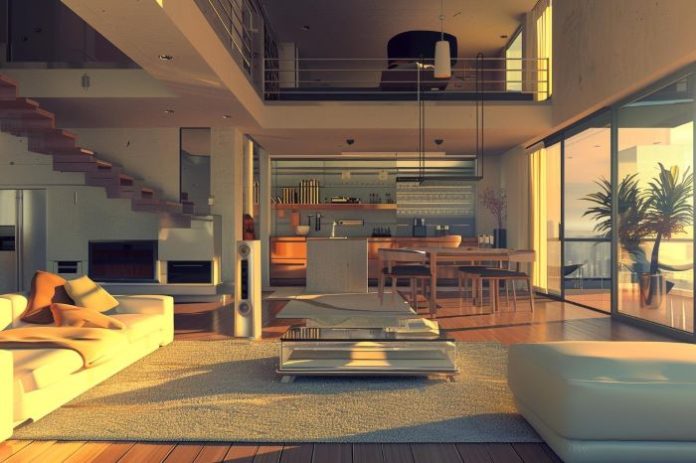The convergence of artificial intelligence with architecture and interior design is redefining how we create and experience homes. Cutting-edge tools like Floor Plan AI and home design AI are moving beyond traditional design assistance. Homeowners can envision living spaces that are adaptive, personalized, and deeply integrated with both human preferences and environmental contexts.
This article explores the future landscape of these AI technologies—highlighting emerging innovations, practical uses, and the challenges that lie ahead.
Table of contents
- The Next Frontier: Integrating Generative Design, VR/AR, and Environmental Data
- Adaptive Home Layouts: AI Responding to Mood and Season
- Forecasting Trends: Machine Learning Meets Lifestyle and Demographics
- Robotics and Automated Construction: Completing the AI Design Cycle
- Ethical, Social, and Regulatory Challenges
- Visionary Ideas: Pioneering the Future of Home Design AI
- How to Use Room Design AI and Floor Plan AI Today
The Next Frontier: Integrating Generative Design, VR/AR, and Environmental Data
Floor Plan AI and home design AI are evolving from simple layout and style generators into intelligent systems leveraging generative design principles. AI can now create optimized home layouts by automatically iterating thousands of possible configurations based on constraints such as space, light, and flow.
When combined with virtual reality (VR) and augmented reality (AR) interfaces, users gain immersive experiences—walking through AI-generated home designs before committing to builds or renovations.
Real-time environmental data, including weather patterns, sunlight angles, and temperature variations, are being integrated into these AI platforms. For example, Floor Plan AI might adjust window placements or shading structures dynamically depending on seasonal sun positioning, ensuring energy efficiency and comfort. Meanwhile, home design AI adapts interiors based on environmental inputs such as humidity or outdoor noise, creating resilient, human-centered living environments.
Adaptive Home Layouts: AI Responding to Mood and Season
Looking forward, home design AI will not only generate static designs but also autonomously modify interiors and layouts in response to occupants’ moods and seasonal preferences. Imagine your living room subtly shifting color palettes or rearranging furniture to evoke calmness in the evenings or boost energy in the mornings.
Sensors and smart home systems can feed data into home design AI, triggering dynamic transformations. Similarly, Floor Plan AI could reconfigure modular walls or adaptable storage units to reflect seasonal living needs—expanding cozy indoor spaces during winter or opening up areas seamlessly during warmer months. Through machine learning, these AI systems learn resident behaviors, anticipating and implementing design changes that improve lifestyle satisfaction.
Forecasting Trends: Machine Learning Meets Lifestyle and Demographics
One of the most promising roles of AI in modern housing lies in its ability to forecast lifestyle and demographic trends. By analyzing vast datasets on population movements, cultural shifts, and economic factors, Floor Plan AI and home design AI can anticipate the evolving needs of communities and individuals alike.
For instance, as multigenerational living gains popularity, AI systems may prioritize flexible layouts that accommodate multiple families under one roof. Machine learning algorithms can also detect emerging preferences for sustainability, wellness-centric spaces, or smart technology integration—feeding these insights back into design recommendations.
This predictive capability allows architects and homeowners to future-proof their investments, crafting spaces that stay relevant through changing social and economic dynamics.
Robotics and Automated Construction: Completing the AI Design Cycle
The innovations in home design AI are matched by advances in construction robotics and automation. Floor Plan AI outputs are increasingly compatible with AI-powered robotic systems capable of executing complex building tasks with precision and speed.
Autonomous bricklayers, 3D concrete printers, and drone-assisted site surveys are already complementing AI-generated models. In the near future, the synergy between Floor Plan AI and construction robotics could enable on-demand, customizable home builds that minimize human labor and error. Rapid prototyping through AI can directly translate into physical construction, making the housing market more responsive to real-time demand.
Ethical, Social, and Regulatory Challenges
Despite these exciting developments, the path toward fully automated home design AI raises important ethical and social questions. Privacy concerns emerge as AI systems collect detailed lifestyle and environmental data to drive adaptive designs. Who owns this data, and how securely is it managed?
Socially, there may be resistance to homes that change autonomously, impacting occupants’ sense of stability and control. Regulatory frameworks must evolve to govern AI-generated designs and robotic construction practices. This ensures safety, accessibility, and quality standards while fostering innovation.
Visionary Ideas: Pioneering the Future of Home Design AI
Startups and research institutions at the forefront of home design AI innovation include companies like Spacemaker AI, which uses generative design to optimize urban housing projects, and Modsy, which merges AI-driven design with user-friendly AR visualization.
University labs worldwide are advancing AI models that integrate emotional analytics and environmental simulation. This change pushes the boundaries of what intelligent homes can achieve. Pilot projects are already adopting AI-driven workflows from conceptualization to construction, validating both the benefits and challenges of these technologies in real-world settings.
How to Use Room Design AI and Floor Plan AI Today
Even now, AI tools empower users with no prior design experience to create beautiful, functional spaces with ease.
To use Room Design AI:
- Upload a room photo: Take a picture of your space and upload it.
- Select style & room type: Choose your preferred design style and room category.
- Generate and download: Instantly view redesigned room renderings and save high-resolution images for sharing or implementation.
For Floor Plan AI:
- Upload or describe: Start by uploading a photo or outlining your vision.
- AI processing: The system analyzes your input and generates multiple optimized layout options.
- Download & share: Select your favorite plan, download it, and share with architects or contractors.
Conclusion
Floor Plan AI and home design AI stand at the intersection of technology, creativity, and human experience. By integrating generative design, environmental awareness, adaptive interiors, and robotics, these innovations promise homes that evolve alongside their inhabitants and surroundings.
Harnessing this potential requires thoughtful approaches to privacy, ethics, and regulation—ensuring that home design AI enhances, rather than complicates, our daily lives. As visionary companies and researchers push forward, the next decade will redefine what it means to live intelligently, comfortably, and beautifully.











